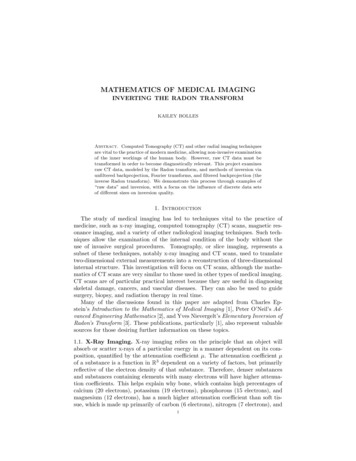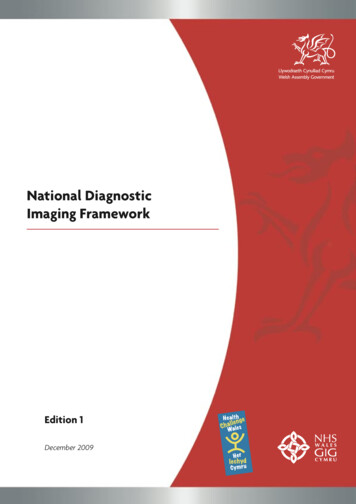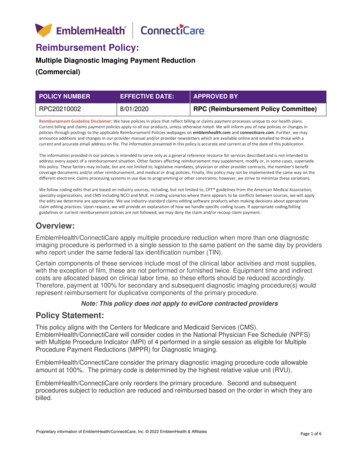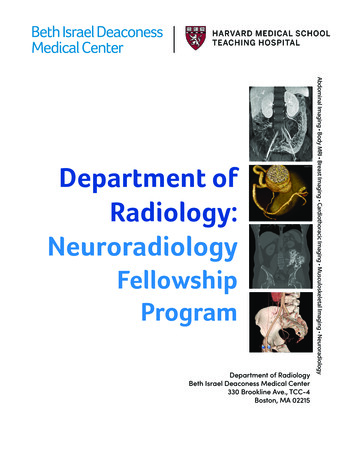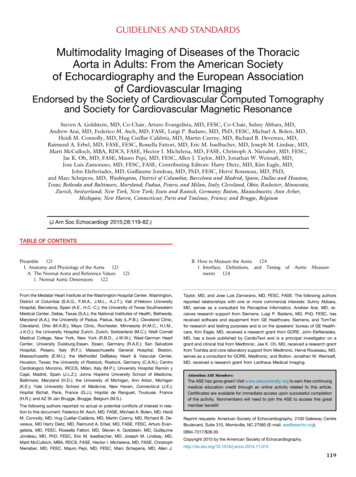
Transcription
Developing an EnterpriseImaging StrategySession #212, March 8, 2018Dawn Cram, IS Director Enterprise ImagingOchsner Health System1
Conflict of InterestDawn Cram, RT(R,M), CIIPHas no real or apparent conflicts of interest to report.2
Agenda Enterprise Imaging Governance Establish mission Determine current state Create vision and identify key characteristics Conduct needs assessment & gap analysis Develop strategy Develop SMART goals3
Learning Objectives Evaluate considerations when developing an enterprise imagingstrategy Identify organizational and workflow drivers impacting strategicdirection Develop a SWOT matrix to guide enterprise imaging strategy andtactical planning Compare enterprise imaging strategic approaches Design an effective enterprise imaging strategy tailored to yourorganization4
Enterprise Imaging a set of strategies, initiatives and workflows implemented across a healthcare enterprise to consistently and optimally capture, index, manage, store, distribute,view, exchange, and analyze all clinical imaging and multimediacontent to enhance the electronic health recordRoth CJ, Lannum LM, Persons KR. J Digit Imaging (2016) 29: 530.5
Enterprise Imaging6
Enterprise rovisioningResourcelevels ngemanagementWorkflows7Marketing
Enterprise Imaging - Community8
Enterprise ImagingProviders need to do theirhomework up front to understandthe scope and goals they have How can a vendor provide asolution to customers who do notknow what they want to solve?The C-suite really needs to lead outwith enterprise imaging, but today,enterprise imaging is regulated to aposition of limited resources andalignment.9
Enterprise Imaging Incorporation of Enterprise Imaging Foundational Goals Multidisciplinary Workflow support Analytics Patient engagement Integration Interoperability10
Why Start? Financial Risk aversion Availability Accessibility Hardware Agnostic Systems Systems Replacement– Contract ending– Consolidation11
Governance Differences in structure:– Imaging Informatics Governance Committee– PACS Governance Committee– IT Physician Advisory Committee Evolves with imaging service line expansion– Key imaging service line stakeholder representation Solid charter addressing–Current member roles and needs–Future member roles and needs12
Governance Image definition Mission Image retention Vision Where images will be accessed Strategy Where images will be stored Goals How images will be stored Systems integration Workflow support Imaging device standards13
Mission Overall purpose Basis for strategic plan Align with organizational mission Inspire14
MissionExample Healthcare Organization Mission StatementTo improve the health of our community through accessibility, education, quality and –transformation–functionality15
Current State Existing architecture Drivers– Internal– External Processes16
Current State: Existing Architecture Electronic Health Record (EHR) Document Management System (DMS) Ancillary information systems Image repositories Image viewers Interface engine Infrastructure Business continuity17
Current State: Organizational Drivers Organization type and structure– Large, complex health system– Community Hospital– Academic Medical Center Goals & strategic alignment For profit vs not-for-profit Regional considerations Patient population18
Current State: Service Line DriversOperational DependencyDepartmental Specific Radiology 100% Goals Cardiology 85% Strategy Ophthalmology 80% Business development initiatives Pathology 60% Provider satisfaction OB-GYN 50% Financial impact Dermatology 50% Stakeholders19
Current State: Processes Image definition Imaging device standards Image retention Procurement Where images are accessed User provisioning Where images are stored Change management How images are stored Testing Systems integration Release of information Workflows Information management Downtime Image management20
Current State: SWOT Considerations Financial Engagement- Investment- Prioritization- ROI- Stakeholder buy-in- Business development- Sr. Leadership support Resources Technical constraints- Core team staffing level- Infrastructure- Other team dependencies- Data security policies- Experience- Legacy system(s), storage21
SWOT – IT vs Clinical DrivenWEAKNESSES (–)INTERNALFACTORSSTRENGTHS ( ) Established Imaging Governance Senior Leadership buy-in Experienced team Current support model and resource levels Low prioritization of Enterprise Imaging initiatives Historically poor workflow compliance Existing core systems technology is legacyEXTERNALFACTORSOPPORTUNITIES ( )THREATS (–) Limited service line representation in Governance Existing procurement procedures Regulatory changes Data center restructuring PACS replacements required (funding) Advanced external readings (business growth)22
Recap Mission Current State Next steps– Vision– Goals– Needs Assessment & GapAnalysis– Strategy– SMART goals23
Vision: Considerations Broad impact– Imaging community– Governance “optimal state”– Stakeholder input– Organization goals– Drivers Communicates easily and effectively– Motivates– Inspires24
Vision Begin with the end in mind alue creation– Common purpose: The Patient– Bridge gap between strategyand innovation– Supports provider excellence25
GoalsExample Enterprise Imaging VisionA multidisciplinary, multifunctional medical imaging systems environment adding value for ourclinicians and patients Multidisciplinary:- Value adds:– standards adherenceall medical imaging Multifunctional:– interoperability– imaging relativity– patient engagement– comparison capabilities– tele-consults– advanced subspecialtyvisualization– cutting-edge expertise26
DEFINING CHARACTERISTICSEnterprise availability and accessibility of all medical imaging2020 VISIONA multidisciplinary,multifunctionalmedical imagingsystems environmentadding value for ourclinicians and patientsRobust multidisciplinary and multifunctional imaging relativity,comparison capabilities and advanced subspecialtyvisualizationAdherence to standards providing a high level of interoperabilityboth internal and externalValued added improvements supporting patient engagement andtele-consultsRecognition, such as through HIMSS Analytics achievement, forenterprise imaging excellence and cutting-edge expertise27
Recap Mission Current State Vision Goals Next steps– Needs Assessment & GapAnalysis– Strategy– SMART goals28
Needs Assessment Image sharing / exchange Business Continuity Patient engagement Performance Cost reduction Newer technologies Analytics Specialty considerations andchallenges Encounters-based workflow Non-DICOM support Mobile image capture Resources Support model Centralization Security29
Gap Analysis Available technologies– DICOM only ingestion– Gap Non-DICOM ingestion Staff skill level / knowledge– Radiology PACS specific– Gap understanding of otherimaging specialties Workflows supported– Orders only– Gap encounters (EBIW)30
Recap Mission Current State Vision Goals Needs Assessment & GapAnalysis Next steps: Define– Strategy– SMART goals31
Strategy Identify top 5 goals Approach– “Lead the industry in patientengagement” Method to achieve– “Implement methods supportingpatient management andaccessibility of the medicalimaging record and imagedependent consults”32
Goals: SMART Align with Vision and Key Characteristics–“Lead the industry in patient engagement throughimplementation of methods supporting patientmanagement and accessibility of the medicalimaging record and image-dependent consults”Example Goal 1: Enhance patient engagementExample Goal 2: Enhance patient engagementby implementing self record managementthrough the patient portal, reducing CDrequests by 10% within first 12 months ofdeployment.33
Challenges & Goals Analysis Financial Staffing Existing architecture No existing EIR Vision not defined -begin with the end in mind Goals not imaging-specific “Imaging” not defined Systems or tools not currently available to achieve Leadership support needed to achieve34
Key Measures KPIs:1) Reduce 5/10 YR TCO by 20%2) Reduce downtime (99.99% uptime)3) Reduce CDs by 10% within 12 months of patient portal integration Growth:1) Integration of imaging specialties outside Radiology and Cardiology At least 10 specialties added by 2020 People:1) Increase imaging provider satisfaction by 30% as determined by baseline and post implementation surveys2) Improve imaging provider productivity by more than 10% as determined by average RVUs – baseline and post implementation metrics35
Objectiveso Missiono Vision Goalso Short-termo Long-term Strategyo Top 5 goals withstrategy to achieve Key MeasuresExample of a draft strategy from Ochsner HealthSystem, IS Department, Enterprise Imaging36
Recap Mission Current State Vision Goals Needs Assessment & GapAnalysis Strategy SMART goals Next steps: Plan / Execute37
Strategic ApproachesAcademicHealth SystemCommunity Hospital Medium, complex Large, complex Smaller footprint No replacement Replacement Replacement No EIR Legacy Repository Has EIR Priority Risk Priority Function Priority CostEIR install & nontraditional servicelinesReplace EIR &change distributionmodelReplace38
Planning Operating Procedures: multi-specialty image capture, imagemanagement, downtime Policies: user provisioning, image retention, release of information Change Management plan: adaption and adoption Metrics and analytics: surveys, measure success Shared cost model: flat, usage Value creation: bridging gap between strategy and innovation39
Planning: Organizational Impacts Marketing– External image sharing / exchange Finance– How to distribute costs? Patient community– Ability to manage own record Aligning with organizational strategy– Prioritization40
Preparing For Change Targets of change– Everyone– Collaboration and engagement for success Agents of change– Project manager– Project owner(s)– System owner(s)– Physician champion(s)– C-suite41
QuestionsDawn Cram, CIIP, RT(R,M)IS Director, Enterprise ImagingOchsner Health SystemEmail: dawn.cram@ochsner.orgTwitter: @DawnCramCIIPLinkedIn: https://www.linkedin.com/in/dawn-cram-24a10b1742
Developing an Enterprise Imaging Strategy Session #212, March 8, 2018 Dawn Cram, IS Director Enterprise Imaging Ochsner Health System. 2 . Current State: Existing Architecture Electronic Health Record (EHR) Document Management System (DMS) Ancillary information systems

